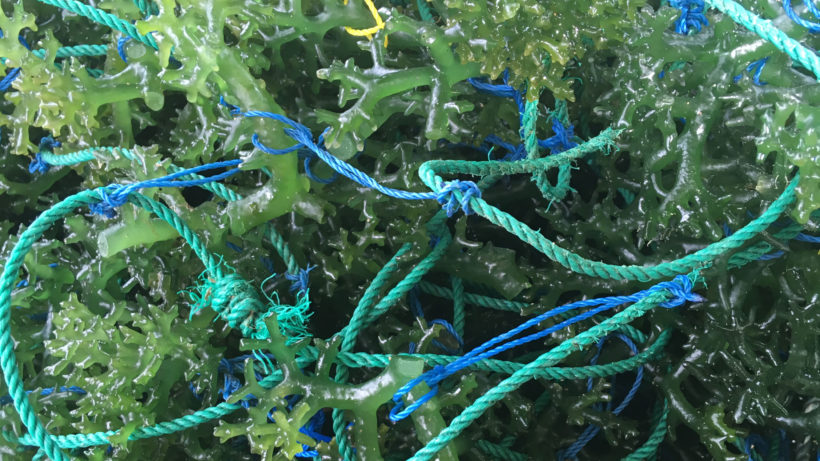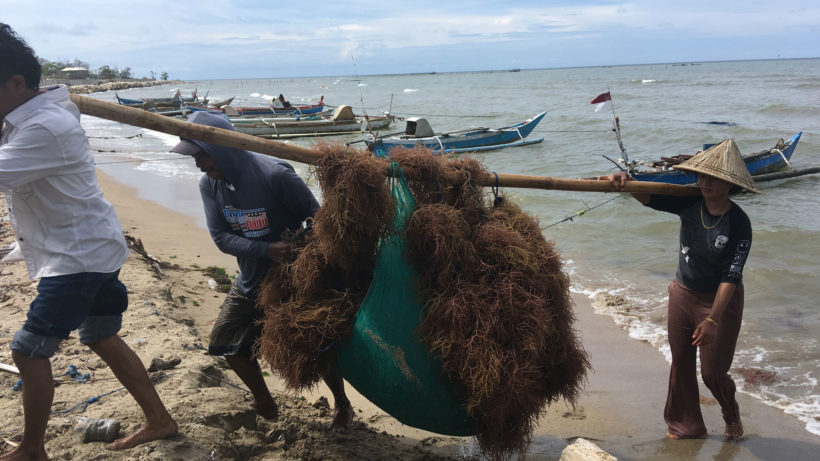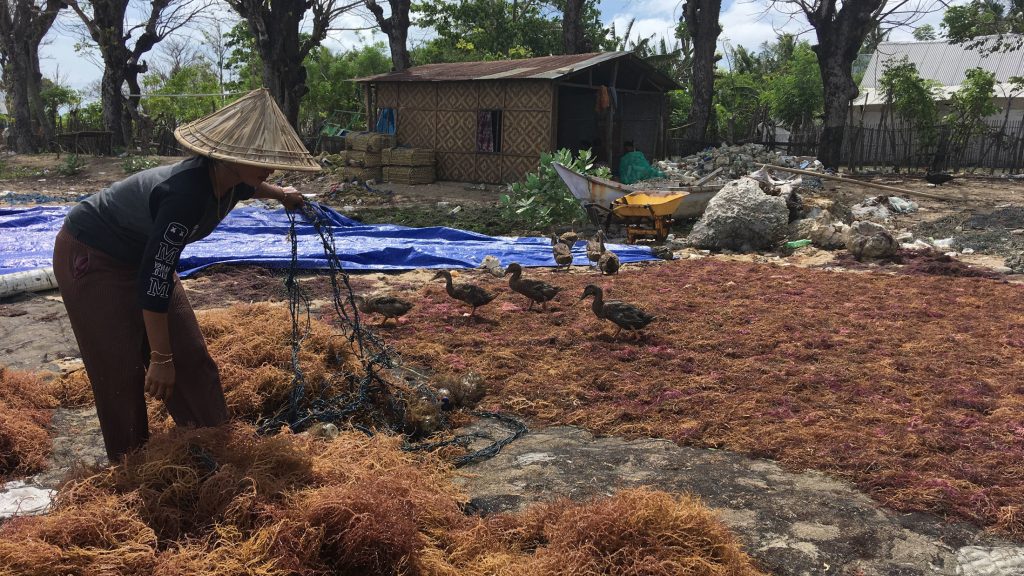“What does your husband do while you’re working on the seaweed lines?”, we ask. She laughs and says in Bahasa, “He does the cooking and the cleaning.”
It’s day 6 of our field visit to Indonesia and we’re in Takalar visiting our fifth island and third seaweed farm of the trip. On the brink of the ‘extreme season,’ stifling hot is an understatement, but the light breeze from the Flores Sea provides a welcome break from the three flights and 2-hour van trip that brought us here.
Seaweed farming is one arm of the massive and growing aquaculture industry in Indonesia, representing 37% of the world’s seaweed production, producing over 10 million tons annually.
Seaweed is a globally-traded commodity for used for carrageenan (a thickening ingredient in common food products and cosmetics), direct consumption, and may even have value for other purposes like sustainable animal feeds. It’s an incredibly important industry in Indonesia for rural, indigenous, and – as confirmed by our visit to South Sulawesi – women. World Bank analysis even shows that expanding seaweed farming in tropical areas like Indonesia may further boost local incomes, food security, and environmental health.
As compared to many other farming practices, seaweed is seen by some as the pinnacle of sustainable aquaculture, requiring no feed other than sunlight and marine nutrients, holding the ability to remove excess nutrients from eutrophic areas, and even mitigating the effects of ocean acidification.
Seaweed requires no freshwater to grow, which is particularly important for remote islands in Indonesia where the ability to raise traditional crops is limited and climate change projections include increasing temperatures and prolonged dry seasons.
Seaweed farming can also serve as an important alternate livelihood to more destructive practices, such as the unfortunately common ‘blast fishing’ where fishermen use explosives or poison to stun or kill fish, decimating corals and other habitats in the process. The Indonesian Navy has even heralded seaweed farming as an alternative livelihood to piracy, training ex-pirates how to farm with the intent of keeping them from returning to a life of crime.
However, like most issues – the reality and environmental chain impacts are incredibly complex. Seaweed farming can also compete with other marine uses and cause severe environmental degradation, with many farmers removing seagrasses, digging up coral reefs, and even cutting down mangroves for use as wooden stakes.

Plastic waste from water bottles used as buoys for seaweed long-lines and polyethylene rope fragments also take a huge environmental toll in contributing to marine plastic debris. Indonesia is the second largest contributor of plastic trash to the world’s oceans, surpassed only by China.
It is through this lens and our goal of providing food and water sustainably that The Nature Conservancy’s involvement in seaweed farming comes into focus.
Rewinding to days 1-5, my first trip to Indonesia began by meeting with TNC’s Indonesia team on Timor and Rote Islands to visit our pilot sustainable seaweed farms where we’re working with farmers in Nusa Tenggara Timur to reduce plastic debris and impacts to corals and seagrasses while simultaneously providing trainings on financial-management, value-added products, and improving yield and drying techniques. Relationship-building, respect for village dynamics, and acknowledgement that seaweed farming is an essential livelihood is key to community engagement and advocacy for sustainable practices.

This is an approach that resonates deeply with me and is why I joined The Nature Conservancy in our new aquaculture program two months prior. I began eating fish and shellfish before I could eat solid food, with my first job at age 12 in aquaculture. My hometown on the Olympic Peninsula of Washington State has more oysters than people, with many of its mix of native and non-native people dependent on marine resources and oyster aquaculture.

A traditional “preservationist” mindset would argue for a demarcation between people and nature – a line in the sand or circle on a map separating the environment from any human influence. A conservationist at heart though, I ascribe to environmental stewardship and biocultural conservation as a necessary path for creating environmental, social, and economic sustainability.
Our work in sustainable seaweed farming in Indonesia is rooted in this triple-bottom-line. If we can work hand-in-hand with communities to improve environmental practices and stewardship, then we can see conservation gains while empowering women and coastal economies – seeing humans and communities as an essential piece of a holistic and lasting solution, rather than just the problem.




Good job! It seems like you’re helping to make a difference in many lives.
Article well written, engaging and clarifying, btw!
Thank you for sharing.
Good work,we followed